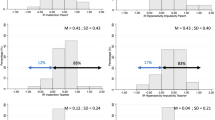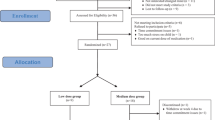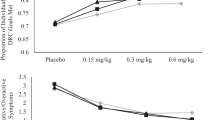Abstract
In this preliminary report from a study in progress, the effects of methylphenidate on behavioral adjustment in children (N=13) with mental retardation (MR) and Attention Deficit Hyperactivity Disorder (ADHD) were investigated using a placebo-controlled, double blind, crossover design. Parent and teacher behavioral ratings, and reports of side effects, were obtained with placebo, 0.15 mg/kg, 0.30 mg/kg, and 0.60 mg/kg BID dosages of methylphenidate. Results revealed significant declines in ADHD symptomatology (e.g., inattention, hyperactivity) with medication treatment, with the most significant declines appearing at the 0.60 mg/kg dose of the medication. No significant behavioral improvements (relative to placebo) were noted below the 0.60 mg/kg threshold, i.e., at the 0.15 mg/kg or 0.30 mg/kg dosages. These preliminary results strongly suggest that teachers may be more sensitive raters of symptoms of ADHD, or else may simply have more opportunity to observe the core symptoms of ADHD in a setting in which such symptoms are most likely to be problematic. Although teachers appeared to be more sensitive raters of ADHD symptomatology, parents may have been more sensitive raters of symptoms of side effects than were teachers. Results suggest that both parents and teachers provide important information in titrating stimulant medication in children with MR and ADHD.
Similar content being viewed by others
References
Aman, M. G. (1996). Stimulant drugs in the developmental disabilities revisited.J. Develop. Phys. Dis. 8: 347–365.
Aman, M. G., Kern, R. A., McGhee, D. E., and Arnold, L. E. (1993). Fenfluramine and methylphenidate in children with mental retardation and ADHD: Clinical and side effects.J. Am. Acad. Child Adol. Psychiatry 32:851–859.
Aman, M. G., Marks, R. E., Turbott, S. H., Wilsher, C. P., and Merry, S. N. (1991a). Clinical effects of methylphenidate and thioridazine in intellectually subaverage children.J. Am. Acad. Child Adol. Psychiatry 30:246–256.
Aman, M. G., Marks, M. B., Turbott, S. H., Wilsher, C. P., and Merry, S. N. (1991b). Methylphenidate and thioridazine in the treatment of intellectually subaverage children: Effects on cognitive-motor performance.J. Am. Acad. Child Adol. Psychiatry 30:816–824.
Aman, M. G., and Singh, N. N. (1994)Aberrant Behavior Checklist—Community, Supplementary Manual, Slosson Educational Publications, East Aurora, NY.
Aman, M. G., Singh, N. N., Stewart, A. W., and Field, C. J. (1985). Psychometric characteristics of the Aberrant Behavior Checklist.Am. J. Ment. Def. 89:492–502.
Aman, M. G., and Turbott, S. H. (1991). Prediction of clinical response in ADHD children taking methylphenidata.J. Aut. Devel. Dis. 21:211–228.
American Psychiatric Association (1987),Diagnostic and Statistical Manual of Mental Disorders (Third edition, revised), American Psychiatric Association, Washington, D. C.
American Psychiatric Association (1994),Diagnostic and Statistical Manual of Mental Disorders (Fourth edition), American Psychiatric Association, Washington, D. C.
Barkley, R. A. (1990).Attention Deficit Hyperactivity Disorder: A Handbook for Diagnosis and Treatment, Guilford Press, New York.
Barkley, R. A., Fischer, M., Edelbrock, C. S., and Smallish, K. (1990). The adolescent outcome of hyperactive children diagnosed by research criteria, I: An 8-year prospective follow-up study.J. Am. Acad. Child Adol. Psychiatry 29:546–557.
Brown, R. T., and Sleator, E. K. (1979). Methylphenidate in hyperkinetic children: Differences in dose effects on impulsive behavior.Pediatrics 64: 408–411.
Cantwell, D. P., and Carlson, G. Z. (1978). Stimulants. In J. S. Werry (ed.),Pediatric Psychopharmacology: The Use of Behavior Modifying Drugs in Children, Brunner/Mazel, New York.
Conners, C. K. (1989).Conners' Rating Scales Manual, Multi-Health Systems, Inc., North Tonawanda, NY.
Conners, C. K. (1992).Continuous Performance Test: Users Guide, Multi-Health Systems, Inc., North Tonawanda, NY.
Douglas, V. I. (1983). Attentional and cognitive problems. In Rutter, M. (ed.),Developmental Neuropsychiatry, Guilford Press, New York.
Douglas, V. I., Barr, R. G., Amin, K., O'Neill, M. E., and Britton, B. G. (1988). Dosage effects and individual responsivity to methylphenidate in attention deficit disorder.J. Child Psychol. Psychiatry, 29: 453–475.
Feldman, H., Crumrine, P., Handen, B. L., Alvin, R., and Teodori, J. (1989). Methylphenidate in children with seizures and attention-deficit disorder.Am. J. Dis. Child. 143:1081–1086.
Forness, S. R., Swanson, J. M., Cantwell, D. P., Guthrie, D., and Sena, R. (1992). Response to stimulant medication across six measures of school-related performance in children with ADHD and disruptive behavior.Behav. Dis. 19:42–53.
Gadow, K. D., and Pomeroy, J. C. (1990). A controlled case study of methylphenidate and fenfluramine in a young mentally retarded, hyperactive child.Austr. New Zeal. J. Devel. Disabil. 16:323–334.
Gan, J., and Cantwell, D. P. (1982). Dosage effects of methylphenidate on paired associate learning: Positive/negative placebo responders.J. Am. Acad. Child Psychiatry 21:237–242.
Goodman, L. S., and Gilman, A. (1990).The Pharmacological Basis of Therapeutics, Pergamon Press, New York.
Guy, W. (1976),ECDEU Assessment Manual for Psychopharmacology (revised), Department of Health Education, and Human Welfare Publication No. (ADM) 76-338.
Hagerman, R. J., Murphy, M. A., and Wittenberger, M. D. (1988). A controlled trial of stimulant medication in children with the fragile X syndrome.Am. J. Med. Gen. 30:377–393.
Handen, B. L., Breaux, A. M., Gosling, A., Ploof, D. L., and Feldman, H. (1990). Efficacy of methylphenidate among mentally retarded children with attention deficit hyperactivity disorder.Pediatrics 86:922–930.
Handen, B. L., Breaux, A. M., Janosky, J., McAuliffe, S., Feldman, H., and Gosling, A. (1992). Effects and noneffects of methylphenidate in children with metal retardation and AHD.J. Am. Acad. Child Adol. Psychiatry 31:455–461.
Handen, B. L., Janosky, J., McAuliffe, S., Breaux, A. M., and Feldman, H. (1994). Prediction of response to methylphenidate among children with ADHD and mental retardation.J. Am. Acad. Child Adol. Psychiatry 33:1185–1193.
Handen, B. L., McAuliffe, S., Janosky, J., Feldman, H., and Breaux, A. M. (1994) Classroom behavior and children with mental retardation: Comparison of children with and without ADHD.J. Abnorm. Child Psychol. 22:267–280.
Hilton, D. K., Martin, C. A., Heffron, W. M., Hall, B. D., and Johnson, G. L. (1991). Imipramine treatment of ADHD in fragile X child.J. Am. Acad. Child Adol. Psychiatry 30:831–834.
Kupietz, S. S., Winsberg, B. G., Richardson, E., Maitinsky, S., and Mendell, J. (1988). Effects of methylphenidate dosage in hyperactive reading disabled children: I. Behavior and cognitive performance effects.J. Am. Acad. Child Adol. Psychiatry 27:70–77.
Marshburn, E. V., and Aman, M. G. (1992). Factor validity and norms for the Aberrant Behavior Checklist in a community sample of children with mental retardation.J. Aut. Devel. Dis. 22:357–373.
Payton, J. B., Burkhart, J. E., Hersen, M., and Helsel, W. J. (1989). Treatment of ADDH in mentally retarded children: A preliminary study.J. Am. Acad. Child Adol. Psychiatry 28:761–767.
Pelham, W. E., Bender, M. E., Caddell, M. A., Booth, M. A., and Moorer, S. H. (1985). Methylphenidate and children with attention deficit disorder.Arch. Gen Psychiatry 42:948–952.
Pelham, W. E., Walker, J. L., Sturges, J., and Hoza, J. (1989). Comparative effects of methylphenidate on ADD girls and ADD boys.J. Am. Acad. Child Adol. Psychiatry 28:773–776.
Physician's Desk Reference (1991). Oradell, N.J.: Medical Economics Company, Inc.
Quay, H. C., & Peterson, D. R. (1987),Manual for the Revised Behavior Problem Checklist, Available from H.C. Quay, Box 240074, University of Miami, Coral Gables, FL 33124.
Rapport, M. D., Stoner, G., DuPaul, G. J., Kelly, K. L., Tucker, S. B., and Schoeler, T. (1988). Attention deficit disorder and methylphenidate: A multivariate analysis of dose-response effects on children's impulsivity.J. Am. Acad. Child Adol. Psychiatry 27:60–69.
Reich, W., Welner, Z., and Herjanic, B. (1991).Diagnostic Interview for Children & Adolescents-Revised, Multi-Health System, Inc., North Tonawanda, NY.
Sleator, E. K. (1985). Measurement of compliance.Psychopharmacol. Bull. 21:1089–1093.
Sleator, E. K., and Sprague, R. L. (1978). Pediatric psychopharmacology. In: Clark, W. G., and del Guidice, J. (eds.),Principles of Psychopharmacology (2nd ed.), New York: Academic Press, pp. 573–591.
Sleator, E. K., and von Neumann, A. W. (1974). Methylphenidate in the treatment of hyperkinetic children.Clin. Pediatr. 13:19–24.
Solanto, M. V., and Conners, C. K. (1982). A dose-response and time-action analysis of autonomic and behavioral effects of methylphenidate in attention deficit disorder with hyperactivity.Psychophysiology 19:658–667.
Sprague, R. L., and Sleator, E. K. (1977). Methylphenidate in hyperkinetic children: Differences in dose effects in learning in social behavior.Science 198:1274–1276.
Sparrow, S., Balla D., and Ciccetti, D. (1984).Vineland Adaptive Behavior Scales, American Guidance Service, Circle Pines, MN.
Swanson, J. M. (1989). Paired associate learning the assessment of ADD-H children. In Swanson, J. M., and Swanson, L. M. (eds.),Attention Deficit Disorder V.: Emerging trends in Attentional and Behavioral Disorders of Childhood, Pergamon Press, New York, pp. 87–124.
Swanson, J. M., Kinsbourne, M., Roberts, W., and Zucker, K. (1978). A time response analysis of the effect of stimulant medication on the learning ability of children referred for hyperactivity.Pediatrics 61:21–29.
Swanson, J. M., Kurland, L., Weinberg, F., and Kinsbourne, M. (1978). Comparing the behavioral effectiveness of two drugs which have different half lives.Pediatr. Res. 12:376.
Swanson, J. M., McBurnett, K., Christian, D. L., and Wigal, T. (1995). Stimulant medications and the treatment of children with ADHD. In Ollendick, T. H., and Prinz, R. J. (eds.),Advances in Clinical Child Psychology, Volume 17, Plenum Press, New York, pp. 265–322.
Thorndike, R. L., Hagen, E. P., and Sattler, J. M. (1986).Guide for Administering and Scoring the Stanford-Binet Intelligence Scale (fourth edition), Riverside Publishing Company, Chicago, IL.
Triantafillou, M. (1972). Pemoline in overactive mentally retarded handicappel children.Brit. J. Psychiatry 121:577.
Ullmann, R. K., and Sleator, E. K. (1985). Attention deficit disorder children with or without hyperactivity. Which behaviors are helped by stimulants?Clin. Pediatr. 24:547–551.
Ullmann, R. K., Sleator, E. K., and Sprague, R. L. (1985). Introduction to the use of the ACTeRS.Psychopharmacol. Bull. 21:915–920.
Varley, C. K., and Trupin, E. W. (1982). Double-blind administration of methylphenidate to mentally retarded children with attention deficit disorder: A preliminary study.Am. J. Ment. Def. 86:560–566.
Voelker, S., Lachar, D., and Gdowski, C. L. (1983). The Personality Inventory for Children and response to methylphenidate: Preliminary evidence for predictive utility.J. Pediatr. Psychol. 8:161–169.
Wirt, R. D., Lachar, D., Klinedinst, J. K., and Seat, P. D. (1984).Multidimensional Description of Child Personality: A Manual for the Personality Inventory for Children (rev.), WPI, L.A.
Author information
Authors and Affiliations
Rights and permissions
About this article
Cite this article
Pearson, D.A., Santos, C.W., Roache, J.D. et al. Effects of methylphenidate on behavioral adjustment in children with mental retardation and ADHD: Preliminary findings from a study in progress. J Dev Phys Disabil 8, 313–333 (1996). https://doi.org/10.1007/BF02578398
Issue Date:
DOI: https://doi.org/10.1007/BF02578398




